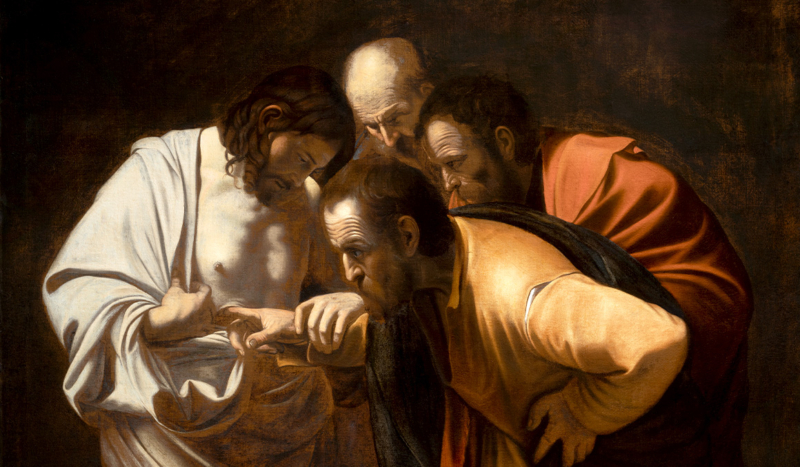
On July 3rd, we celebrate the feast day of St Thomas the Apostle. It is hard to think of St Thomas apart from his reputation as “Doubting Thomas.” In the Gospel of John, Thomas says “…unless I place my hand in his side, I will not believe” (John 20:25, RSVCE).
The doubt of Thomas gives rise to Christ’s patient lesson on faith without sight. In “The Incredulity of St Thomas,” by Caravaggio, we see Christ’s face filled with patience and tender care, even in light of Thomas’ doubt.
Caravaggio depicts this scene with his characteristic technique of chiaroscuro (high contrast of light and dark). The light source illuminates Christ as the predominant figure in the scene. He is the magnetic pull of the scene and seems to draw all the figures into himself. The darkened background is all but nonexistent — all that matters is the conversion moment at the forefront.
The four heads of the figures in the painting are clustered together, illustrating the intimacy and connection at the core of the encounter. If we focus on the finer details of the painting, we see that Thomas’ fingernails are dirtied and his clothes are slightly torn. These external signs of poverty symbolize the internal spiritual poverty of unbelief. This symbolism gives an even greater contrast to the perfect and unsullied robe of Christ and his glorified wounds, an invitation to reflect on our spiritual poverty and our universal need for a savior.
Read the passage from the Gospel below and allow the painting to illustrate the scene in your mind:
Eight days later, his disciples were again in the house, and Thomas was with them. The doors were shut, but Jesus came and stood among them, and said, “Peace be with you.” Then he said to Thomas, “Put your finger here, and see my hands, and put out your hand, and place it in my side; do not be faithless, but believing.” Thomas answered him, “My Lord and my God!” Jesus said to him, “Have you believed because you have seen me? Blessed are those who have not seen and yet believe.” (John 20:26-29, RSVCE)
Thomas’ face is highly expressive. The shock and awe written across his facial features is palpable. The scene depicts the moment right before Thomas proclaims, “My Lord and My God.”
Nonetheless, we can simultaneously see both the gentleness and patience of Jesus when he offers the initial greeting of peace as well as his teaching on the value of faith without sight. The other two figures in the painting are also very eager to see the physical wounds of Christ, but neither comes close to matching the drama written on the face of St Thomas.
On this feast day, let us reflect on the ways God may be calling us to deepen our own faith.
Are we waiting for Jesus to prove himself to us? Or do we know Christ for who he is— “Our Lord and Our God”? Invite the Holy Spirit to come into the areas of your life where you may need an increase in faith. Ask for the intercession of St Thomas for the humility to see ourselves as we truly are (weaknesses, doubt, and all!) as a beloved child of God.

